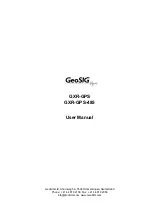
9602-LP User Guide Version A
Document Number: 451-92750-001A
15 of 61
2.2.1
B
AUD
R
ATE
The 9602-LP does not support autobaud; the default baud rate is factory set at 19.2 Kbps.
The baud rate can be reconfigured with the +IPR command ranging from 4.8 Kbps to 115.2
Kbps.
2.2.2
S
ERIAL
P
ORT
The serial port allows a connected DTE to configure the 9602-LP using NAL Research’s
defined AT commands and any terminal emulator software. Find these AT commands in the
manual “AT Commands for Model 9602-LP” [1]. Instead of trying to memorize the various
functions of AT commands, it is easier to use the SatTerm graphical user interface (GUI)
software to configure the 9602-LP.
2.3
TTL/CMOS
I
NPUTS
/O
UTPUTS
The 9602-LP has four TTL/CMOS inputs and three TTL/CMOS outputs. All I/Os are brought
out to the multi-interface connector (min DB-15 connector). Use SatTerm to configure these
I/Os under the I/O tab of the
Configuration Settings
. The
four CMOS/TTL inputs, denoted as S0 through S3, have internal pull-ups, which allow the
inputs to float as high. The inputs can be configured as emergency, test, or general input
with a trigger on a rising and/or falling edge. The trigger activates the special functionality
of the input type.
Input types:
Emergency
configured inputs enable the Emergency Tracking mode when triggered.
Test
configured inputs enable the Test Tracking mode.
General
configured inputs queue the transmission of an Input Report (see Appendix
C in “AT Commands for Model 9602-LP” [1]).
Regardless of the type or trigger configuration, the value of the input is included in any
version 5 GPS report sent. By default, S0 is configured as an emergency input triggered by
a falling edge, and S1 is configured as a test input triggered by a falling edge. S0 is shared
with the onboard Emergency button (see
). This means both the guarded
Emergency button on the 9602-LP and S0 can be used to activate Emergency Tracking.














































